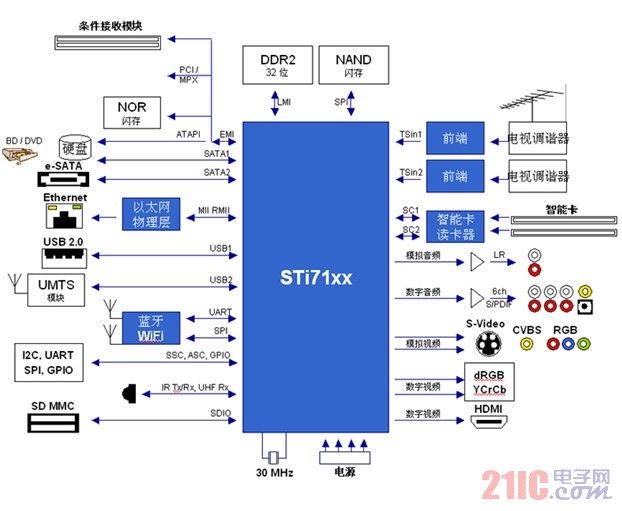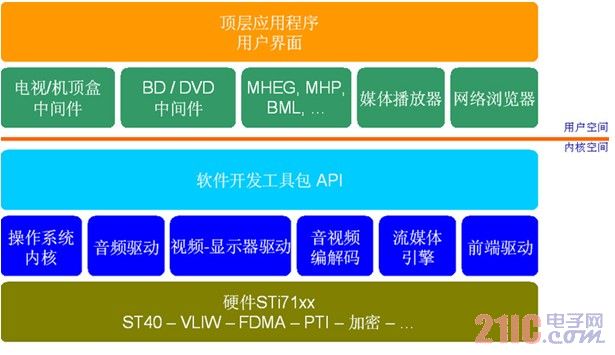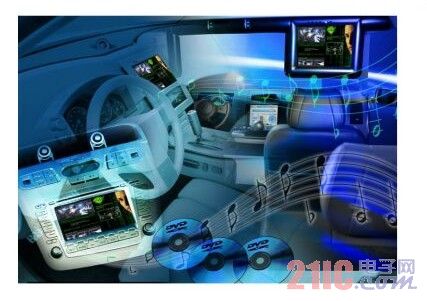introduction
This article refers to the address: http://
Automotive in-car entertainment audiovisual systems include AM/FM radios, cassette tapes, CD players, DVD/VCD players, and more. The rear seat entertainment system is a system that has integrated a variety of media technologies and information technologies in recent years, including a car room integrated (touch) color screen, a car room integrated A/V control panel, a hidden DVD/VCD, and a sound system. Some are also equipped with a dedicated network and communication system to support interactive entertainment.
The next generation of rear seat entertainment systems must cover a wider range of data sources, provide greater interactive support, and integrate more features into the automotive infrastructure, which will not only increase the value of OEM original equipment, but also increase the equipment installed by dealers or The value of retail equipment.
But it is clear that price is one of the key factors in the market for the next generation of rear seat entertainment systems now and in the future. Factors affecting prices include the overall cost of materials and hardware and software, which is mainly the development cost of software. This article focuses on how to reduce the overall cost of materials and software development workload.
A good first impression is the key to a product's broad market acceptance, and the first impression has a lot to do with the ease of operation of the user interface. Obviously, even a very professional entertainment system will not be accepted by the market if the user interface is slow or disruptive to user commands. Market leaders have proven that a smooth, fast user interface is the key to product success. Adding 3D multi-window support can improve the overall ease of use of the system, but this requires an increase in image processing.

1 more features
What features must the rear seat entertainment system support in the future? Of course, DVD-Video must be supported for a long time, which ensures that your child is happy on the way, and your existing CD library can be used for a long time. In addition to DVD-Video, Blu-ray will be the second disc standard supported by the system, as some movie discs are likely to use only the Blu-ray standard in the future. Blu-ray not only has superior audio and video performance, but also improves security. Using the blacklist saved on the disc, Blu-ray can prohibit playback of the disc on the "hacked" player. The growing opportunity to experience interactive content (such as games) on Blu-ray players is a strong evidence to support the growing market acceptance and is also a means of promotion.
In addition to the CDs that carry entertainment content, the next-generation entertainment system must also consider the ability to play movies from other storage media via USB or e-SATA interfaces, such as SD cards, USB flash drives and mobile hard drives, which will inevitably enclose a large number of audio and video packages. The format is introduced into the rear seat entertainment system, so the system must support a large number of file formats, including DivX, XviD, AVI, RealMedia, 3GP, ASV, MOV, OGM, and so on.
The rear seat entertainment system must also consider live broadcasts such as TV broadcasts, the most important of which are terrestrial TV broadcast systems such as DVB-T in Europe, ATSC in the US, ISDB-T in Japan or DTMB in China. In addition, mobile TV standards must also be considered, such as DVB-H in Europe, ATSC-M/H in the United States, T-DMB in South Korea, and CMMB in China. New TV standards will soon appear, such as the mobile satellite satellite broadcasting standard DVB-SH, which is similar to satellite radio broadcasting and is very popular in the United States. There will also be a new live TV channel in the market, which will transmit and broadcast TV programs through existing mobile phone infrastructure.
Our younger generation also needs interactive entertainment content. Internet-connected data lines allow them to use a variety of services, such as YouTube, Twitter, Facebook and many other social networking sites. On this issue, it is clear that the entertainment system architecture also needs to accept a web browser to support common plugins. Only in this way can we provide more entertainment services to users, such as webcasting and Internet TV, and provide users with more kinds of entertainment content as much as possible. Also, why not increase the accessibility of the home media stream engine so that users can remotely access the content recorded at home? This eliminates the need for media content to be transferred or synchronized between the home and the car. Of course, these services require a data transmission service that is at least similar to EDGE or HSDPA, and the access service provider should provide a monthly or yearly charging policy. Once popularized, existing infrastructure will need to be improved or replaced by fourth-generation mobile communications LTE.
In short, the rear seat entertainment system is a combination of residential professional entertainment system and mobile media source - a mobile home. The rear seat entertainment system needs to support the usual robust features, with the flexibility and enhanced features to upgrade to the latest features.

2 Reduced development costs
2.1 Hardware aspects
How can we overcome the challenges of so many features of the entertainment system while keeping development costs low? Obviously, the solution to this problem is mainly to reuse the existing platform architecture outside the consumer electronics industry, providing high-end media playback support and various external interfaces. The huge price pressures force manufacturers to offer cost-effective solutions that are consistent with proven, market-proven features.
ST's entertainment-specific STi71xx supports HD decoding (1080i/p) and multi-channel audio decoding and post-processing. The main application runs on an ST40 processor compatible with the SH4 CPU. The main task of this CPU is to run a client-specific program that controls audio and video signal processing. All audio and video decoding tasks are transferred from the main CPU to two very long instruction word (VLIW) processors. One of the processors is responsible for audio processing and the other is responsible for video decoding. This method of processing audio and video separately from the CPU application helps to reduce system complexity and enhance the overall robustness of the entire system. The audio and video processor is easy to reset if an error occurs while processing corrupted data. Using firmware on both VLW processors increases firmware flexibility. Depending on the codec request, the processor can load one or more firmware to support video encoding standards (such as H.264, MPEG-2, VC-1 or AVS) and audio encoding standards (such as MPEG-2, MP3, WMA, AAC, Dolby, DTS, OggVorbis) and other file formats. In addition, the audio processor performs audio signal mixing, sample rate conversion, stereo multi-channel to dual-channel mixing (down-mix), and post-processing functions such as surround sound. The codec can be upgraded by loading the processor with new firmware, and it is important to ensure that the processor supports new or improved codec standards before loading. The firmware is developed and provided by the chip vendor, so application developers do not have to worry about firmware development and maintenance. Moreover, the driver ensures that the firmware is properly integrated into the main application. Because of the very high flexibility of the firmware, the decoder can also be used for audio and video encoding as well as transcoding to change the format and/or transmission rate of existing streams. The application memory is a 32-bit DDR2 memory, and the three CPUs can directly access the memory, which ensures that the bandwidth-consuming processor has memory priority access.
In addition to multiple CPUs, the 71xx series of system chips also provide video output stage, audio output stage and peripheral interface. The video output stage provides both analog and digital video output. Depending on the system architecture, you can use CVBS, Y/C, RGB for analog connections, or digital RGB, YCrCb or HDMI for digital connections. The 71xx series supports two independent video signal outputs that can be used to drive two rear-seat displays (left and right). The audio output supports a multi-channel digital I2S output with parallel stereo mix signals. In parallel stereo, an on-chip digital-to-analog converter provides stereo analog signals that are compatible with the headphone jack, eliminating the need for an external digital-to-analog converter. Digital audio signals can be transmitted to a remote audio amplifier via a car audio network such as MOST. In addition, the series offers a multi-channel output with S/PDIF capability. The STi71xx series is equipped with a digital audio and video input that allows the rear seat entertainment system to connect to other audio and video equipment, such as digital video cameras.
The system-on-chip concept provides many of the most commonly used peripheral interfaces. Some products in the STi71xx series offer two USB 2.0 ports embedded in the physical layer chip, which can connect USB flash drives, mobile hard drives, UMTS/HSDPA wireless network cards, and so on. If you need more on-chip host ports, you can use the on-board hub to expand the number of USB ports.
To connect internal hard drives and optical drives such as Blu-ray or DVD, the STi71xx series offers two SATA interfaces. In order to connect external SATA devices, these interfaces also support the e-SATA standard. To connect to an old DVD drive, the EMI port also provides a traditional ATAPI parallel port, which is a 16-bit data bus.
There are many ways to access the Internet in a car. You can plug in a UMTS / HSDPA wireless network card on the USB interface, or connect to existing communication devices inside the car via Ethernet. The Ethernet cable can be a wire or fiber optic cable, depending on the vehicle's existing infrastructure. The external UMTS / HSDPA wireless network card eliminates the need to verify the entire system in every country or region. If the end user connects to a USB wireless network card, he will need to handle the network compatibility and service provider's contract. Bluetooth and WiFi connectivity is easy, just add a 2-in-1 device that supports either or both formats. The SDIO interface allows the entertainment system to add an SD or MMC reader. For example, users can view photos in a digital camera and expand the amount of memory used to record TV shows. The on-chip infrared transceiver supports remote control. In addition, the chip is also equipped with peripheral interfaces such as I2C, SPI, UART, GPIO.

In terms of digital TV support, the STi71xx series offers up to three stream input channels, one or two for real-time playback decoding and the third for background TV recording, channel scanning or data services. Compared with home set-top boxes, car TVs need to be prepared to adjust the frequency, because the car is mostly in motion. To handle encrypted content, the STi71xx series has an on-chip encryption core that decrypts major copy protection formats such as TV video protection, DVD-Video, Blu-ray, and streaming copy protection. The keys required for the decryption process can be accessed through two intelligent interfaces. Alternatively, a conditional access module can be connected to the chip to provide the system with the flexibility to connect to a local cryptographic module. With a NAND flash memory, applications and media files or TV recordings can be stored for time-shift viewing, and flash can replace internal hard drives without having to solve the problem of data access during car bumps.
Running the STi71xx family of products requires only a 30 MHz oscillator. The series features an on-chip frequency synthesizer and a voltage-controlled crystal oscillator that internally generates an audio and video decode clock and system clock independently, for example, to synchronize with the broadcaster's clock. An oscillator can reduce material costs compared to other solutions that require multiple clock sources.
The power supply must provide four voltages: 1.2V core voltage, 1.8V DDR2 memory voltage, 2.5V and 3.3V peripheral interface voltage. The average power consumption is about 2W, which is related to the application being implemented. The next generation of products is mainly to reduce power consumption. Driven by the "green" concept and the mobility of media processors, next-generation products not only reduce operating power but also reduce standby power.
This is a brief introduction to the STi71xx family of products from the technical functional level. Some of the technical features can meet the automotive-grade quality standards for OEM applications. We can provide more detailed product and system information if needed.
2.2 Software aspects
Software is another way to solve the problem of how to drive down development costs. Developing a multimedia software stack from scratch is not cost-effective. The proliferation of codecs and package formats has dramatically increased the cost of software development. On this issue, by providing a software stack for the system chip, the chip provider gives the device manufacturer a lot of development support. The software stack integrates the most commonly used audio and video codec software mentioned above. The driver interface provides a well-known API interface for system integrators. Unlike the driver software stack that focuses on all hardware-specific projects, the elements of system development considerations are operating system. The market's strong demand for enhanced media decoding features and online access applications requires the use of an existing application library that provides most of the application software. These software modules are called middleware, and the provider is a software company or open source community that integrates intellectual property within the middleware.
Compared to a rear seat entertainment system with only one DVD, the choice of operating system becomes more and more difficult. Proprietary operating systems have an advantage in terms of code size and efficiency, but require a lot of hardware drivers and application software development work. If you use a familiar operating system such as WinCE or Linux, there are a variety of applications and driver software available. Because the driver software is hardware-specific, the chip vendor must provide the driver in the software development kit. The development kit contains all the components needed to run the application: the operating system, drivers, and codecs. Some open source applications like WebKit browsers or media players may be placed in packages to speed up application development. These applications rely on the existence of video APIs. For example, on Linux platforms, V4L (Linux Video) or ALSA (Advanced Linux Audio Architecture) must exist. Other middleware like DVD-Video or Blu-ray playback engine, MHEG, MHP, BML or Java components can run and be easily implemented on the video API, a process that is independent of the hardware used. Finally, the top-level application that runs the user interface will be the framework for the entire system, and system developers can put a lot of effort into the framework to make it more unique than a competitive system. The on-chip graphics kernel enables developers to create an easy-to-use interactive user interface.
From playing the content of discs and external storage, to live TV decoding and web media streaming, the next generation of rear seat entertainment systems will offer a wealth of features. As end-user usage standards increase, the system-supported video formats will scale from QCIF / QVGA to HD standards. Effective use of existing systems, including hardware and software, is an essential factor in accelerating the development cycle and controlling development effort. A large number of audio and video code development requires long-term experience in the development of consumer electronics devices.
3 Conclusion
In the long-term driving process, passengers in the car will inevitably feel boring, in addition to enjoying high-quality music, people also hope to have more entertainment. After the birth of the car computer, its large screen is often reminiscent of movie screenings. but. In order to ensure the safety of driving and the realization of the functions of the on-board computer, it is obviously not an ideal method to use the on-board computer to play movies. Therefore, the rear seat entertainment system came into being. This system can realize the real-life movie playback while ensuring the safety of driving and achieving high-quality audio-visual enjoyment.
Cob Led Module,rgb led Module,rgb led smd module,Colorable Led Ceiling Light
Shenzhen Isource lighting Co., Ltd , https://www.isourceled.com